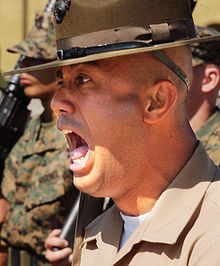Basic training
In the basic training of an armed force , the training participants, usually recruits , are taught basic military skills in a social , technical local process.
The term is to be distinguished from further training for specialization or for admission to NCO or officer corps .
overview
The Canadian military historian Gwynne Dyer describes basic training as a form of conditioning in which those involved are encouraged to give up part of their individuality for the benefit of their unity .
This definition applies to different armed forces to different degrees. While some training programs aim to break the recruits' personality as quickly as possible in order to reshape them, others aim to weaken individualism while maintaining central characteristics in order to make the recruit more adaptable to the armed force. The boundaries between these two approaches are fluid.
General procedure
As a rule, the belongings that recruits have with them on arrival at the place of basic training are confiscated and kept for the duration of the basic training. Both if they successfully or if they leave basic training prematurely, they get their property back, even if some armed forces threaten to do so only in the event of success. This is supposed to represent a symbolic farewell to civil life.
The recruits then complete the final formalities and examinations in a fixed procedure. Not infrequently, in countries with a volunteer army , they do not have to sign a legally binding commitment document until after arriving at the training location and, up to a certain point in time, they can bring up previously concealed facts that are important for the training with impunity. In addition, they are given a limited cooling off period. In addition to the increased practicality for the administration in the sense of immediacy, this brings the convocation closer to an initiation rite.
After the final engagement, the recruits will be given undecorated uniforms and other utensils. This is followed by further uniformity with a short haircut. Women are usually allowed to have their hair tied up to a certain length.

effect
The intended effect of basic training aims at several aspects, but above all at the psyche and physique of the individual recruits as well as those of their community as a whole.
Physique
Most of the time, the physical requirements of basic training are at a demanding level, with a. Marches , bivouacs , long-distance runs that have to be mastered in the course of training and the subsequent recruit inspection and the ATN exam to become a security soldier . Therefore already in are recruiting certain physical demands placed on the recruits.
psyche
Psychological influencing of the recruits is inevitable for conditioning them to form a unit. The background to this is the security risk that an individually dispensed soldier can pose in combat. Therefore, the new soldier is subjected to a program that encourages discipline and aims to make him part of a unit. In addition, the training can lead to constant stress, especially for recruits with no professional experience, as real relaxing breaks are often rare despite numerous idle phases between the training phases. Some military also place great value on indoctrination of the corps spirit during basic training.